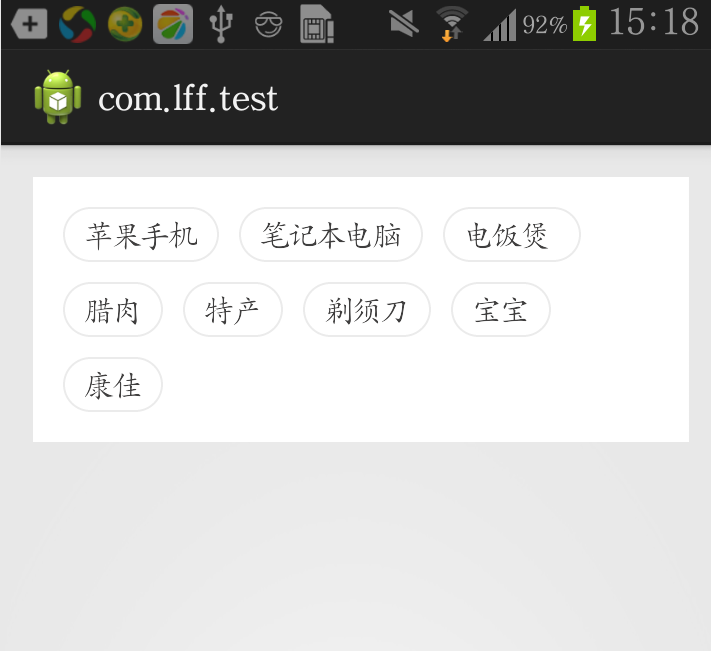Android 實現FlowLayout流式佈局(類似熱門標籤)
阿新 • • 發佈:2019-01-07
今天跟大家分享一下FlowLayout,最近專案中有遇到熱門標籤這個樣的佈局(文章末尾可下載原始碼),如下圖:
一,建立FlowLayout並繼承ViewGroup
FlowLayout 類主要實現onMeasure,onLayout和generateLayoutParams方法,具體如下看程式碼註釋;
public class FlowLayout extends ViewGroup
{
public FlowLayout(Context context, AttributeSet attrs, int defStyle)
{
super(context, attrs, defStyle);
}
public 二,在MainActivity呼叫實現
public class MainActivity extends ActionBarActivity {
private String[] mVals = new String[] { "蘋果手機", "膝上型電腦", "電飯煲 ", "臘肉",
"特產", "剃鬚刀", "寶寶", "康佳" };
private LayoutInflater mInflater;
private FlowLayout mFlowLayout;
@Override
protected void onCreate(Bundle savedInstanceState) {
super.onCreate(savedInstanceState);
setContentView(R.layout.activity_main);
mInflater = LayoutInflater.from(this);
mFlowLayout = (FlowLayout) findViewById(R.id.id_flowlayout);
initData();
}
public void initData() {
/**
* 找到搜尋標籤的控制元件
*/
for (int i = 0; i < mVals.length; i++) {
TextView tv = (TextView) mInflater.inflate(
R.layout.search_label_tv, mFlowLayout, false);
tv.setText(mVals[i]);
final String str = tv.getText().toString();
//點選事件
tv.setOnClickListener(new OnClickListener() {
@Override
public void onClick(View v) {
}
});
mFlowLayout.addView(tv);//新增到父View
}
}
}
1,MainActivity的xml佈局
注意 佈局當中的com.example.com.lff.test.FlowLayout
activity_main.xml
<RelativeLayout xmlns:android="http://schemas.android.com/apk/res/android"
xmlns:tools="http://schemas.android.com/tools"
android:layout_width="match_parent"
android:layout_height="match_parent"
android:paddingBottom="@dimen/activity_vertical_margin"
android:paddingLeft="@dimen/activity_horizontal_margin"
android:paddingRight="@dimen/activity_horizontal_margin"
android:paddingTop="@dimen/activity_vertical_margin"
tools:context="com.example.com.lff.test.MainActivity" >
<TextView
android:layout_width="wrap_content"
android:layout_height="wrap_content"
android:text="@string/hello_world" />
<com.example.com.lff.test.FlowLayout
android:id="@+id/id_flowlayout"
android:layout_width="fill_parent"
android:layout_height="wrap_content"
android:background="#FFFFFF"
android:padding="10dp" >
</com.example.com.lff.test.FlowLayout>
</RelativeLayout>
2,單個標籤空間的佈局,也就是上述Activity中的search_label_tv.xml
search_label_tv
<?xml version="1.0" encoding="utf-8"?>
<TextView xmlns:android="http://schemas.android.com/apk/res/android"
android:layout_width="wrap_content"
android:layout_height="wrap_content"
android:layout_margin="5dp"
android:textColor="#3f3e3e"
android:background="@drawable/search_label_bg"
android:textSize="14sp"
android:text="Helloworld" >
</TextView>
結束語:簡單,清晰,明瞭。歡迎大家指正吐槽。

